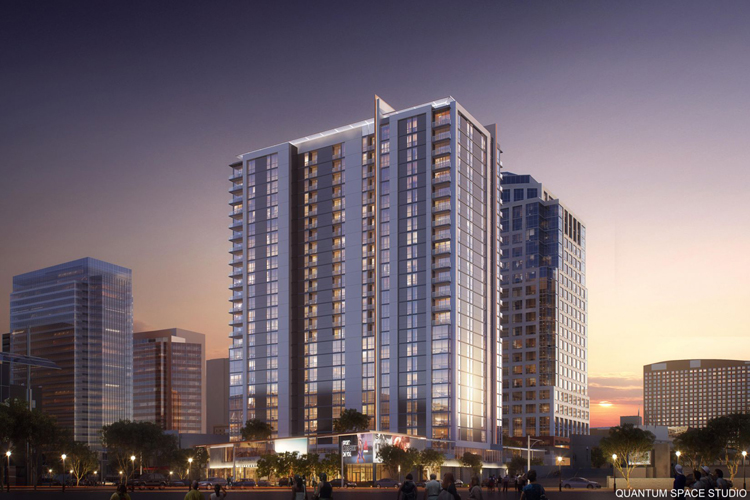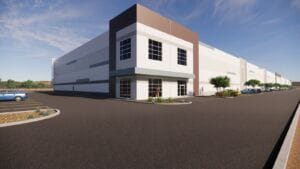The multifamily market weathered the pandemic much better than other commercial real estate sectors, according to report from Kidder Mathews. While rent growth fell below historical averages, average monthly rent collections remained above 93 percent every month last year according to the National Multi Housing Council Rent Payment Tracker and overall vacancy remained within historical norms. Facing a global pandemic and an unprecedented national economic shutdown, multifamily fundamentals impressed.
Moving into 2021, the distribution of the vaccines allowed a relaxation of many of the pandemic restrictions and a return to near normalcy throughout most of the country. That ignited an accelerated recovery of the multifamily market, driving occupancy and rent growth up, and market cap rates down. The nationwide shortage of both for-sale and rental housing has created a frenzy of demand that has far overrun supply. The compelling market fundamentals have drawn a flood of investment capital into the sector with over $130 billion in multifamily transactions closed through 3Q2021, almost double the total 2020 volume.
READ ALSO: ECO Mesa sustainable apartment complex breaks ground
Multifamily markets in the west region of the country are also experiencing dynamic growth driven by skyrocketing demand for rental units. Through the third quarter, more than 89,800 rental units have been absorbed in the seven markets named below, which is 70,900 more units than were absorbed in all of 2020.
This tremendous absorption has resulted in an average vacancy decrease of 226 basis points (bps) across the seven markets. San Diego led all seven markets with the lowest vacancy through 3Q of 2.4% while San Francisco clocked the highest vacancy at 5.6%, a 580-bps improvement over its 2020 vacancy rate of 11.4%. Median year-over-year rent growth through the third quarter was 10.3% in the seven markets, with Phoenix enjoying the highest rate of asking rent growth at 22.4% and Los Angeles posting the lowest at 5.6%. The rent increases driving such high year-over-year rent growth exceeded prepandemic levels in every market except San Francisco. Through the third quarter, average rent rates were 11.2% higher than the rent rates in 2019. Phoenix has the greatest asking rent increase over 2019 rates at 27.1% while L.A.’s asking rent rate is 4.1% greater than in 2019. San Francisco’s asking rental rate is still 5.9% below the 2019 rate.
Such strong performance metrics caught the attention of investors who responded with over $30.5 billion in sales activity, an increase of 35.5% over 2020’s sales volume. Phoenix leads all seven markets with $10.4 billion in sales volume through the end of the third quarter with L.A. a close second at $7.9 billion. Across all seven markets, per unit pricing rose 12.9% thus far this year.
By every metric, the multifamily markets in these seven cities came out of the pandemic much stronger than they were going into 2020. A closer look at each market’s performance follows below.
PHOENIX
Driven by nation-leading population growth, household formation, strong employment growth, and a low cost of living, the Phoenix multifamily market went into the pandemic with solid fundamentals and growing demand. So, the pandemic did little to slow Phoenix’s apartment market. In fact, vacancy dropped 60 bps in 2020 while asking rent grew 5.5% to $1,187 per month. This year the Phoenix market ignited. Unprecedented demand drove vacancy down to 4.4%, its lowest recorded point, and year-over-year rent growth up to 22.4% one of the highest in the nation. Yet even with such high rent growth, asking rent reached only $1,436/month in the third quarter, still one of the most affordable rental rates in the western region.
Phoenix was an investor favorite before the pandemic as the strong fundamentals outlined above and cap rates higher than west coast markets attracted yield-driven investors to the Valley of the Sun. Factors related to the pandemic—and not the Phoenix apartment market—muted sales activity in the first half of 2020 but sales volume rebounded in the second half of the year and has carried over into this year. By the end of the third quarter, sales volume hit $11.1 billion, the most ever recorded and the per unit pricing jumped 23% to $265,537 per unit. As a result, cap rates have steadily compressed, hitting a low of 4.3%.
LOS ANGELES
The pandemic last year caused some of the worst conditions for the L.A. apartment market in over a decade. Vacancy increased 110 bps while rent growth dropped into negative territory for the first time since the first quarter of 2009. But 2021 has been a different story. Vacancies have fallen 200 bps to 3.9% through the third quarter and rent growth accelerated over 700 bps to 5.6%. Average asking rent in the third quarter stands at $2,019/month.
Sales transactions halted in the early stages of the pandemic, but activity picked up in the fourth quarter last year. 2020 sales volume was down 36% from 2019, but volume has returned to historical norms over the past 12 months. Per unit pricing has jumped 11.8% this year to $328,167. The market cap rate decreased 40 bps to 4.3% on a year ago basis.
SAN DIEGO
San Diego multifamily was phased little by last year’s pandemic. In fact, while rent growth slowed, both occupancy and asking rent grew. This year, driven by the strongest demand in 20 years, the apartment market has ignited with occupancy jumping to 97.6% and rent growth accelerating 12.7% through the third quarter to $2,001 per month. Trailing 12-month net absorption has reached an all-time high in 2021, up 59.5% over 2020 with 8,681 units absorbed through the end of September.
Despite the solid fundamentals of the market last year, financial insecurities in the nation kept sales volume down, dropping 2.3% from 2019. This year the strong performance of the market has generated extreme interest among an expanding buyer pool in San Diego. Through September, sales volume has increase 71% over 2020, up from $2.3 billion to over $3.9 billion. Per unit pricing, however, declined 11.2% through the third quarter this year to $281,581. This high level of transaction activity has compressed the market cap rate in San Diego 60 bps to 3.9%.
SAN FRANCISCO
Overwhelming job losses at the onset of the pandemic drove renters out of San Francisco, devastating the multifamily market. One of the worst markets hit by the pandemic, vacancy doubled to 11.4% while rent growth tumbled to -11.5%, with asking rent dropping $355/ month to $2,738/month. Net absorption also ended the year in negative territory registering -7,290 units. This year positive demand returned to the market, but on a less fervent pitch than the other west region markets. Vacancy has improved 420 bps to 7.2% while rent growth has moved into positive territory at 6.1%. Asking rents ended the third quarter at $2,949, up 8.9%, still below their prepandemic peak.
Last year’s depressed market fundamentals gave buyers pause. Sales velocity slowed nearly two-thirds from 2019’s pace and sales volume fell 49.5%. Per unit pricing fell over 7%, falling below $600,000 for the first time since 2017. But as student renters and white-collar professionals began returning to the city, vacancy, rent growth and absorption all improved. Positive asking rent growth helped push per unit pricing up 7.5% to $642,959/unit, still below prepandemic pricing. Interestingly, the metro’s long history of strong multifamily returns kept the market cap rate constant at 3.6% through 2020 and into this year.
SEATTLE
Seattle’s apartment market experienced much the same pandemic-induced slowdown seen in L.A. and San Francisco last year. Vacancy increased 130 bps to 6.7% while rent growth fell into negative territory at -2.7%. Absorption decreased over 9,000 units from 12,451 in 2019 to just 3,179 last year while asking rent declined 2.7% to $1,686/month. The market has made a strong comeback this year with vacancy dropping to 4.6%, the lowest in 20 years. Over 17,000 units were absorbed in the first three quarters of the year. Rent growth has leaped 11.3%, the highest recorded for this market driving asking rent up to $1,876/month.
Sales transactions in the Seattle metro area have increased in the second half of 2021 after a sluggish start earlier in the year. Over the past 12 months, 370 sales have closed, higher than the historical average of 340 sales per year. Through the third quarter, sales volume stood at $4.5 billion, a 36% increase over the total 2020 sales volume, and more in line with 2017 and 2018 sales. Despite the substantial decrease in sales volume from 2019 ($7.9 billion) to 2020 ($3.3 billion), the 2020 per unit sales price increased slightly to $329,096. This year, per unit pricing has increased 4.9% to $345,138, well above prepandemic pricing.The average market cap rate stands at 4.3%, down 70 bps from 2020.
PORTLAND
While Portland suffered record-high job losses early in the pandemic, renters were able, for the most part, to remain in their apartments due to federal and state rental eviction moratoriums and rental assistance. Another factor favoring Portland’s occupancy is the relatively low rental rates when compared to other coastal cities. Thus, vacancy only increased by 20 bps to 6.2% last year, while average asking rent actually increased slightly to $1,342 per month. Coming into this year the rental market intensified sharply and through the end of the third quarter, vacancy has fallen 200 bps to 4.2% and rent growth has vaulted to a year-over-year average rate of 9.4%, the highest recorded rate in Portland. That rent growth led to the highest historic asking rent rate in Portland at $1,457 per month.
Leading into the pandemic, sales volume exceeded $2 billion in both 2018 and 2019. Last year, financial uncertainty slowed sales activity in Portland early in the year, but a busy fourth quarter helped drive total sales to $1.8 billion. The accelerated fourth quarter sales activity continued into this year pushing sales volume up 37% through the third quarter to $2.5 billion. Although the average market cap rate stayed at 4.6% last year and so far, this year, the average effective price per unit exploded 44.1% this year to $244,170.
RENO
Reno’s apartment market has been in growth mode since the end of the Great Recession due to the market’s growing economy, strong in-migration and expanding employment base. During the height of the pandemic last year, apartment demand in Reno accelerated to an all-time high driving vacancy down to 5.5% while rent growth of 5.6% drove asking rent to $1,342 per month, a 5.9% increase. This year, the expansion has continued as vacancy fell another 160 bps to 3.9%, the lowest since the fourth quarter of 2006. Rent growth has accelerated further, hitting 11.6% in the third quarter, leading to an asking rent increase to $1,486 per month.
Last year sales volume in Reno grew by $34 million over 2019 to $336 million as demand for rental housing continued to expand at an accelerating pace. The robust demand continued into this year driving solid absorption and rent growth. Through the third quarter, sales volume has hit a new high, breaking through the $400 million mark at $479 million. Reno’s historical average sales volume has been $131 million. This record-breaking sales volume has propelled per unit pricing over $200,000 for the first time in the metro’s history, hitting $223,417 per unit in the third quarter. The strength of the market is also evidenced by its falling cap rate, dropping 20 bps on a year ago basis to 4.5% in the third quarter.
Outlook
The demand drivers propelling the apartment market show no signs of abating any time soon. Millennials who either can’t afford a home or are renters by choice, baby boomers downsizing to the convenience of apartment living, employees preferring to work remotely, and immigration are just a few of the demand drivers putting significant pressure on the apartment industry for more product. On the supply side, the availability and cost of land, the rising cost of building materials, the availability of workers, and burdensome rules and regulations, such as rent control, have made production difficult and costly. According to a study commissioned by the National Apartment Association (NAA) and the National Multifamily Housing Council (NMHC), in addition to the already existing supply-demand imbalances around the country, meeting projected demand will require building more than 325,000 new apartment homes each year through 2030-a number not met since 1989.
Strong rent growth will persist as demand will continue to outstrip supply for the foreseeable future. It is unlikely though that such growth will continue at a double-digit rate as that pace is exceptional and could not be sustained long-term. But it is reasonable to expect annual rent growth to continue at rates above the national average for the next 18 to 24 months.
1 CoStar
2 The markets covered in this report are Los Angeles, Phoenix, Portland, Reno, San Diego, San Francisco, and Seattle.




